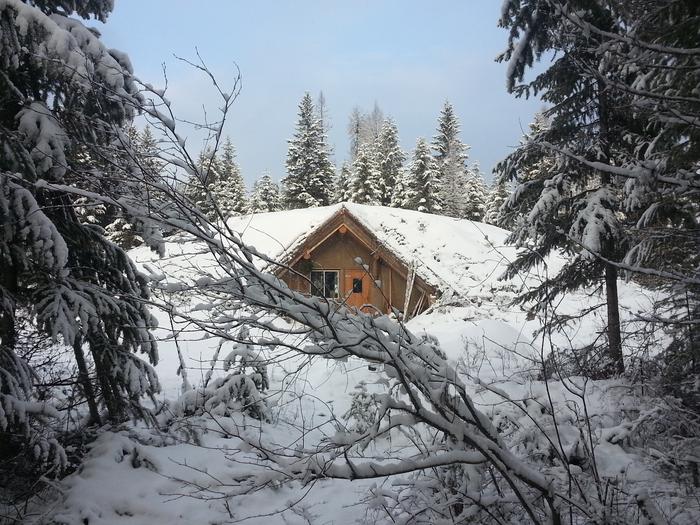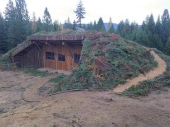Beautiful photos, Evan!
Paul, per your concerns, I have been thinking of the door weatherproofing...
A doorstop is the strip of wood typically 1/4 inch by 1 inch, nailed to the sides (jams) and top (lintel) of a door frame to stop the door from swinging all the way through the doorway when closed. Typically, thin 1/4 inch wide strips of foam can be attached to the doorstop side facing the door so that when the door is closed, the foam is compressed and the door is sealed weather tight.
I was thinking that a more eco friendly solution than foam might be a very loosely twisted (or braided) thick wool rope glued to the stop, similar to the way fireproof rope is used to seal a wood stove door air tight. Or very thick soft rubber might work. It needs to be something that compresses to half its thickness or smaller to provide the best seal against imperfectly aligned surfaces. The stop also needs to be in the correct position all the way around as well.
You could make a modern style weatherproof threshold by stuffing an old bicycle innertube with some old rags, and nailing it to the threshold in alignment with the door stop (or slightly further toward the door opening side) sticking up slightly above the bottom of the door, so the door compresses and slides over it when closed creating a tight seal. But I don't think this would hold up against foot traffic too well.
In lieu of a modern style weatherproof threshold that uses very durable synthetic rubber, you could extend the wood stop across the threshold. I think for the threshold stop, since it will most likely get stepped on, I would make it much wider so it extends from the door stopping position, all the way to the edge of the threshold (i.e. a board rather than a strip of wood). This will stand up to foot traffic better and should be made of locust or other very hard, rot proof wood.
If you haven't already considered this, you may want to make the stop much thicker than the normal 1/4 inch to provide more surface area for weatherproofing. Perhaps 1 inch by 1 inch.
And you need a good latch that pulls the door tightly closed enough to compress the weatherproofing on the stops. A wooden "dog" similar to the metal dogs used on the hatches of ships might work, and only require a single round hole through the door for the shaft, which might not be too difficult to seal with wool and a cover plate. The dog could be carved so that it gets thicker across its width so the harder you twist it shut, the more tightly it pulls the door to the doorstops. That will give you a little more adjustability than a single position door latch, so you can dog the door tightly against the doorstops, even as the wood door and frame changes shape due to changes in temperature and humidity. If the door is a kiln dried, well sealed (waterproof) dimensionally stable door, this is less of an issue and a single position latch will do fine.
Perhaps I should visit a few of these historic buildings around here and see how they weatherproofed their homes.

Which reminds me, my Grandmother had a long tube of fabric filled with sand that she laid up against the door to stop the wind from blowing between the threshold and door, but that only works when someone is inside to put it in place.
Food for thought. Best of luck!


 3
3






















 1
1








 2
2









.png)

 1
1













